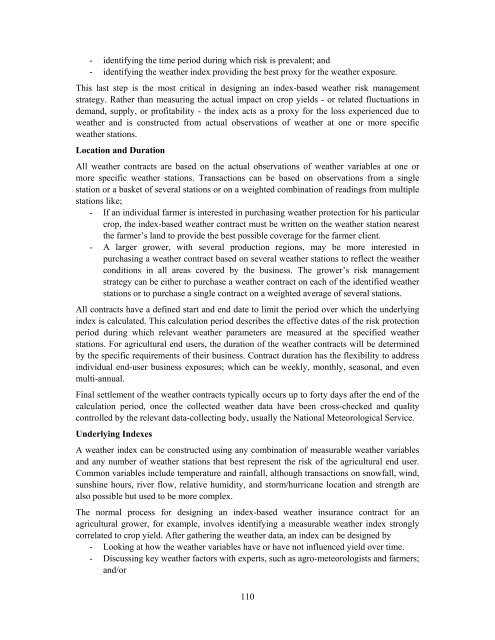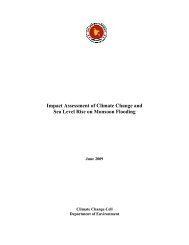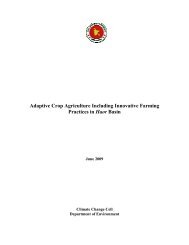Crop Insurance as a Risk Management Strategy in Bangladesh
Crop Insurance as a Risk Management Strategy in Bangladesh
Crop Insurance as a Risk Management Strategy in Bangladesh
You also want an ePaper? Increase the reach of your titles
YUMPU automatically turns print PDFs into web optimized ePapers that Google loves.
- identify<strong>in</strong>g the time period dur<strong>in</strong>g which risk is prevalent; and<br />
- identify<strong>in</strong>g the weather <strong>in</strong>dex provid<strong>in</strong>g the best proxy for the weather exposure.<br />
This l<strong>as</strong>t step is the most critical <strong>in</strong> design<strong>in</strong>g an <strong>in</strong>dex-b<strong>as</strong>ed weather risk management<br />
strategy. Rather than me<strong>as</strong>ur<strong>in</strong>g the actual impact on crop yields - or related fluctuations <strong>in</strong><br />
demand, supply, or profitability - the <strong>in</strong>dex acts <strong>as</strong> a proxy for the loss experienced due to<br />
weather and is constructed from actual observations of weather at one or more specific<br />
weather stations.<br />
Location and Duration<br />
All weather contracts are b<strong>as</strong>ed on the actual observations of weather variables at one or<br />
more specific weather stations. Transactions can be b<strong>as</strong>ed on observations from a s<strong>in</strong>gle<br />
station or a b<strong>as</strong>ket of several stations or on a weighted comb<strong>in</strong>ation of read<strong>in</strong>gs from multiple<br />
stations like;<br />
- If an <strong>in</strong>dividual farmer is <strong>in</strong>terested <strong>in</strong> purch<strong>as</strong><strong>in</strong>g weather protection for his particular<br />
crop, the <strong>in</strong>dex-b<strong>as</strong>ed weather contract must be written on the weather station nearest<br />
the farmer’s land to provide the best possible coverage for the farmer client.<br />
- A larger grower, with several production regions, may be more <strong>in</strong>terested <strong>in</strong><br />
purch<strong>as</strong><strong>in</strong>g a weather contract b<strong>as</strong>ed on several weather stations to reflect the weather<br />
conditions <strong>in</strong> all are<strong>as</strong> covered by the bus<strong>in</strong>ess. The grower’s risk management<br />
strategy can be either to purch<strong>as</strong>e a weather contract on each of the identified weather<br />
stations or to purch<strong>as</strong>e a s<strong>in</strong>gle contract on a weighted average of several stations.<br />
All contracts have a def<strong>in</strong>ed start and end date to limit the period over which the underly<strong>in</strong>g<br />
<strong>in</strong>dex is calculated. This calculation period describes the effective dates of the risk protection<br />
period dur<strong>in</strong>g which relevant weather parameters are me<strong>as</strong>ured at the specified weather<br />
stations. For agricultural end users, the duration of the weather contracts will be determ<strong>in</strong>ed<br />
by the specific requirements of their bus<strong>in</strong>ess. Contract duration h<strong>as</strong> the flexibility to address<br />
<strong>in</strong>dividual end-user bus<strong>in</strong>ess exposures; which can be weekly, monthly, se<strong>as</strong>onal, and even<br />
multi-annual.<br />
F<strong>in</strong>al settlement of the weather contracts typically occurs up to forty days after the end of the<br />
calculation period, once the collected weather data have been cross-checked and quality<br />
controlled by the relevant data-collect<strong>in</strong>g body, usually the National Meteorological Service.<br />
Underly<strong>in</strong>g Indexes<br />
A weather <strong>in</strong>dex can be constructed us<strong>in</strong>g any comb<strong>in</strong>ation of me<strong>as</strong>urable weather variables<br />
and any number of weather stations that best represent the risk of the agricultural end user.<br />
Common variables <strong>in</strong>clude temperature and ra<strong>in</strong>fall, although transactions on snowfall, w<strong>in</strong>d,<br />
sunsh<strong>in</strong>e hours, river flow, relative humidity, and storm/hurricane location and strength are<br />
also possible but used to be more complex.<br />
The normal process for design<strong>in</strong>g an <strong>in</strong>dex-b<strong>as</strong>ed weather <strong>in</strong>surance contract for an<br />
agricultural grower, for example, <strong>in</strong>volves identify<strong>in</strong>g a me<strong>as</strong>urable weather <strong>in</strong>dex strongly<br />
correlated to crop yield. After gather<strong>in</strong>g the weather data, an <strong>in</strong>dex can be designed by<br />
- Look<strong>in</strong>g at how the weather variables have or have not <strong>in</strong>fluenced yield over time.<br />
- Discuss<strong>in</strong>g key weather factors with experts, such <strong>as</strong> agro-meteorologists and farmers;<br />
and/or<br />
110





